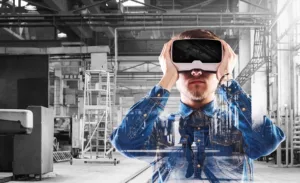When trying to demonstrate the effectiveness of XR, and creating stronger buy-in, which is more important—showing the data or telling powerful stories? My sense of things is that showing quantifiable results usually wins the day. But don’t we all love a good story?

In a recent webinar entitled “XR for Enterprise: How to gain buy in and prove its value”, a digital offering from (XR) Intelligence by Reuters Events, a small panel of speakers demonstrated this tension between good stories and solid data. The speakers hailed from a rich array of industries and interests, featuring
- Shelly Peterson (Lockheed)
- Stephen Paul (AECOM)
- Earl Sison (Thermo Fisher Scientific)
The discussion was expertly facilitated by Mark Sage from “The AREA”, an alliance for promoting enterprise XR. An excellent summary/analysis of this webinar was penned last month by my MEKO colleague, Norbert Hildebrand, entitled “XR for Enterprises: ROI and Buy-in”. I listened to the same webinar as did Norbert, but I escaped the hour with a slightly different perspective. I zeroed in on how we can best demonstrate the value of VR. The benefits. The results. Again, is that better done with numbers or anecdotes? As the facilitator, Mark Sage, correctly reasoned: “You have to start convincing the bean counters, the people with the budget, that you need more money to develop [a] project…“
Two of the webinar’s three speakers were heavy on anecdotes and use cases. And, of course, use cases are simply, in my mind, powerfully communicated stories. Starting three years ago, Sison (from Thermo Fisher Scientific) seemed to rely mainly on use cases and teasing out innovators or “forward thinkers”, as he describes them, to promote XR in his firm. Use cases were important, he explained, because “we depend on others’ budgets [and] have to present to other departments to get funding.” He fussed over the “song-and-dance sell” that always seemed to be necessary. His entire mission seemed to be dependent upon finding internal customers or influential champions who “want to do something new, something different” in order to push the technology forward. The only data points offered by Sison were the vanity metrics of customer engagement at exhibit hall booths, although the company is considering inserting advertising promo codes within the VR experience as a trackable metric. To my readers, I offer this whispered aside: [this approach to demonstrating value seems like such a heavy lift].
A second panelist, Stephen Paul from AECOM, also relied on mostly anecdotal evidence of XR’s value proposition within his organization. According to Paul, VR was deployed because they initially “wanted to build more interactivity into their visualization experiences” for marketing. Paul offered a rich and descriptive array of VR successes within his company, featuring such astute practices as visualization, safety education, and customer engagement. But he truly seized my attention when he softly associated some rough data points with his attractive use cases, such as:
- Statistically reducing accidents through VR-based “slip, trip and fall” training at a nuclear waste site
- Saving some money on traveling, by bringing designers together virtually from Los Angeles, London, Hong Kong, and Denver, while also opening up new and unanticipated collaboration between geographically separated colleagues
- Win a new project due to stakeholder VR visualization
Paul recognized that their justifications for using XR are “not as solid, numerically”; their emphasis remains strongly anecdotal. Still, stories are inspiring, if not useful.
In the next article in this three-part series, we will focus on the third speaker, Shelly Peterson of Lockheed. Shelly operates in a much different world—a world of data and quantifiable results—and the value of XR in the enterprise rises to an entirely new level of importance. Come back next month for a splendid story in my sequel article, “Chasing Data in Enterprise XR and Beyond.” – Len Scrogan

